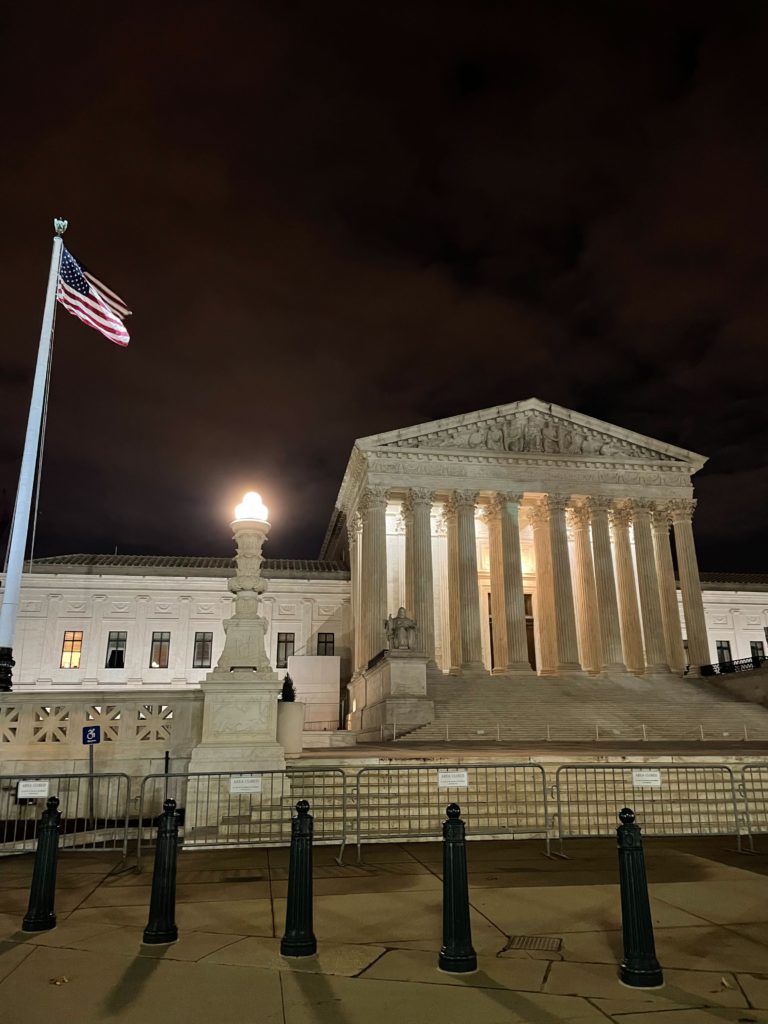The following is an excerpt from our Saturday email, which includes our musings on the latest developments impacting public employees, links to that week’s labor news, and a collection of whimsical reads for your weekend. If you’d like to receive our weekly email, you can use the sign-up form at the bottom of this page. We promise to respect your inbox, and we will never share your email address.
At 5:30am on Monday morning, I filed behind a group of people lined up on the sidewalk outside of the U.S. Supreme Court. I was hoping to see the Court argue a case called Ohio Adjutant General’s Department v. Federal Labor Relations Authority. AFFT filed an amicus brief in support of the petitioners in the case.
This was my first time attempting to see the Court argue a case, and I quickly learned this was also true for everyone who’d joined me in line.
There’s quite a bit of mystery surrounding the Supreme Court, and this is certainly true for visiting the Court. People really do start lining up at 4:30am. And yes, it is true that there are a very limited number of seats – usually 50 – for the public.

While in line, I chatted with a family from New Jersey, a family from California, and a group of NLRA attorneys. It seemed everyone was as curious about the process of being admitted to the Court as a visitor, and so most of our chatting centered around what we’d heard from someone who’d been there before or what we’d read online. “What are the lockers like?” “Can you really not bring anything into the courtroom?” “When I get inside, I’m asking for a comment box. I can’t believe how antiquated this system is!” “Do you really need a quarter for the lockers?”
People left the line to walk to a nearby Starbucks for coffee and then returned, relieved to see the security guards hadn’t been by to distribute those famous paper tickets. People snacked on the food they brought, and a few people lounged on pillows they’d brought in a duffel bag. The duffel bag, it turned out, was the subject of much speculation about whether it would be allowed inside (it was) and if it would fit in a locker (it did).
Once I received my green ticket – number 26 – I was led with a group of people to the front of the building. After climbing the stairs, we waited as security ushered us inside the building in groups of five. We were told to throw away our snacks and water before walking through a metal detector not unlike what you see at the airport.


A policeman met us at the top of a grand marble staircase and gave us The Security Talk. The talk was serious. Nothing was allowed inside the courtroom. No phones, no Apple watches, no Fitbits. If you demonstrate or make a disturbance of any kind, you will be removed from the courtroom, arrested, and taken to a DC jail. Demonstrating inside the courtroom carries a minimum 1-year sentence in a federal prison, so the policeman looked us each in the eye and said, “No demonstrating.”
He ended The Security Talk with “Oh, and you don’t need a quarter for the lockers anymore.” As if on cue, everyone in line looked around in surprise. But this was the inside intel we carried with us!
Once we pledged to be quiet and untether ourselves from our phones, we were ushered to the famous lockers, which no longer required a quarter. From there we walked through yet another metal detector, stood still while someone waived wand around us to ensure we kept our promise and locked our phones away, and then stood before the giant wooden doors that led to the courtroom. Each time the door cracked open, I could see those famous heavy red curtains.
There were several women all dressed in a uniform of grey skirt, blazer, and cream blouse. These women ushered us into the courtroom, and if we were so brave, would usher us out if we needed a bathroom break. These women also sat behind the Justices and were responsible for delivering notes on square slips of white paper to the Justices and refilled their silver or white tumblers. (I still can’t figure out the need for two tumblers. Justices Barrett and Jackson drank from both a silver tumbler and a white tumbler. Maybe one for water, one for tea?)
The proceedings were every bit as interesting as I’d hoped. The audio was so faint at times, I struggled to make out the words of the attorneys arguing or a Justice asking a question, but to read the facial expressions was an incredible experience. I watched as Justice Clarence repeatedly leaned so far in his tall black, leather chair I thought he’d surely fall backwards. I studied Justice Alito’s face and wondered if he was angry or if that was just his Concentrating Face. Justice Jackson got heated the same way I do when I’m passionate about something. Justice Kagan was able to delicately steer a tense line of conversation into calmer waters. Justice Barrett asked clarifying questions I thought surely were for my benefit. Justice Robert handled the day like a captain of a ship. Justice Sotomayor did not hide her allegiance to unions – not one bit. And Justice Gorsuch held a gentle tone throughout his questioning.
All in all, it was a marvelous day. I can see now why everyone I met in that line outside had never been to the Court before. My legs still ache from standing on concrete for so long! I would recommend it to anyone interested in witnessing an incredible part of America’s government.
